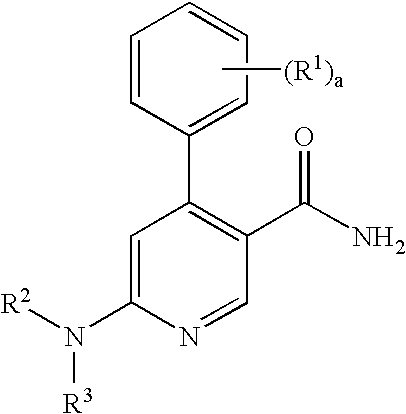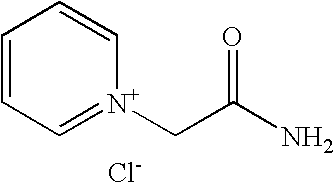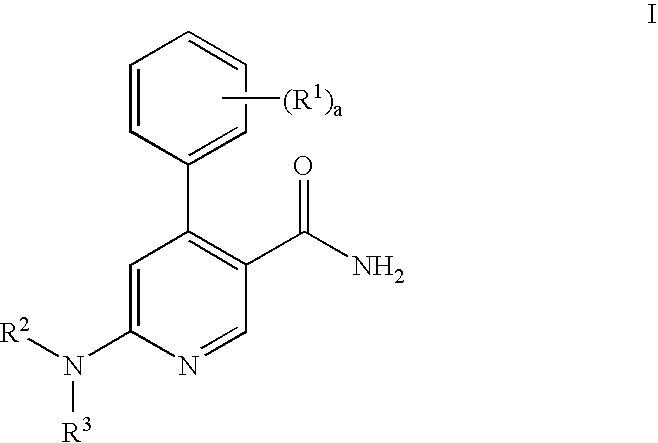Process for preparation of pyridine derivatives of NK-1 receptor antagonist
a technology of nk-1 receptor antagonist and pyridine derivative, which is applied in the field of pharmaceutical process chemistry, can solve the problems of low overall yield of this process, high cost of this process, and safety hazards
- Summary
- Abstract
- Description
- Claims
- Application Information
AI Technical Summary
Benefits of technology
Problems solved by technology
Method used
Image
Examples
example 1
[0121] This example illustrates a process for preparing 4-fluoro-2-methylbenzaldehyde (Fig. III, Scheme I)
[0122] 2-Bromo-5-fluorotoluene (37.5 mL, 56.1 g, 297 mmol) was dissolved in 500 mL of dry THF and the solution was cooled to −78° C. Butyllithium in hexanes (2.5 M) (119 mL, 297 mmol, 1.0 equiv) was added at −75 to −78° C. over 35 minutes, and the resulting mixture was stirred at −78° C. for 20 minutes. Dry N,N-dimethylformamide (27.6 mL, 26.0 g, 356 mmol, 1.2 equiv) was added over 26 minutes at −75 to −78° C. The resulting solution was stirred at −78° C. for 60 minutes then allowed to warm to 15° C. over 2 hours.
[0123] Ammonium chloride (100 g of 15.9% aqueous solution) was added over 5 minutes at 15-20° C. The solution was concentrated by fractional distillation (597 mL collected at 50-61° C.). The distillation pot layers were separated. The aqueous layer was extracted three times with 25 m]L of methyl tert-butyl ether (i.e., MTBE). The organic layers were combined, washed w...
example 2
[0124] This example illustrates a process for preparing methyl 2-cyano-3-(2-methylphenyl) -2-propenoate (Fig. IV, Scheme I)
[0125] A 100-mL, 1-necked round bottom flask (with magnetic stir-bar and dry N2 adaptor) was charged with 11.6 mL (12.0 g, 100 mmol) of o-tolualdehyde, 8.8 mL (9.9g, 100 mmol) of methyl cyanoacetate, and 50 mL of isopropanol. Morpholine (0.50 mL, 0.55 g, 6.3 mmol, 6.3 mol%) was added and the mixture was stirred at 20-33° C. for 60 minutes. This mixture was diluted with 25 mL of isopropanol. The precipitate was filtered, washed with 10 mL of isopropanol, and dried to afford 17.37 g (86.3%) of methyl 2-cyano-3-(2-mehtylphenyl) -2-propenoate as a colorless solid.
example 3
[0126] This example illustrates a process for preparing 1-(2-amino)-2-oxoethylpyridinium chloride (Fig. VI, Scheme I)
[0127] A 3-L, 4-necked round bottom flask (with reflux condenser / dry N2 adaptor, perforated Teflon paddle stirrer with glass shaft, septum with Teflon-coated thermocouple, and Teflon stopper) was charged with 190.76 g (2.04 mol) of 2-chloroacetamide, 2.0 L of n-butyl acetate and 192 mL (187.8 g, 2.37 mol) of dry pyridine. The resulting mixture was refluxed for 24 hours, and then cooled to 25° C. The precipitate was filtered, washed with 500 mL of n-butyl acetate and twice with 500 mL of hexanes, and dried to afford 324.05 g (92.0%) of 1-(2-amino)-2-oxoethylpyridinium chloride as a beige colored solid.
PUM
| Property | Measurement | Unit |
|---|---|---|
| reaction temperature | aaaaa | aaaaa |
| reaction time | aaaaa | aaaaa |
| reaction time | aaaaa | aaaaa |
Abstract
Description
Claims
Application Information
 Login to View More
Login to View More - R&D
- Intellectual Property
- Life Sciences
- Materials
- Tech Scout
- Unparalleled Data Quality
- Higher Quality Content
- 60% Fewer Hallucinations
Browse by: Latest US Patents, China's latest patents, Technical Efficacy Thesaurus, Application Domain, Technology Topic, Popular Technical Reports.
© 2025 PatSnap. All rights reserved.Legal|Privacy policy|Modern Slavery Act Transparency Statement|Sitemap|About US| Contact US: help@patsnap.com



